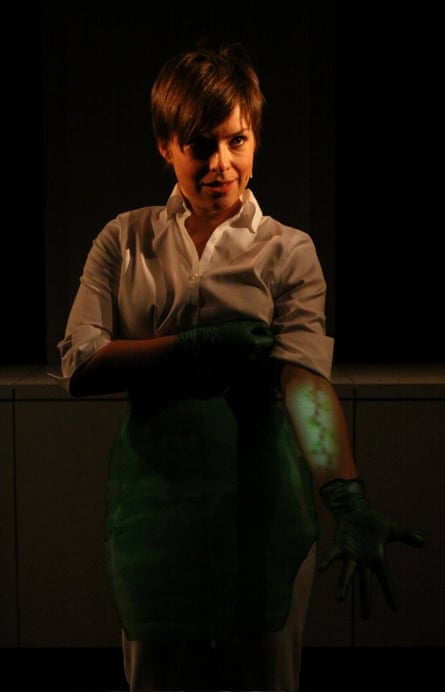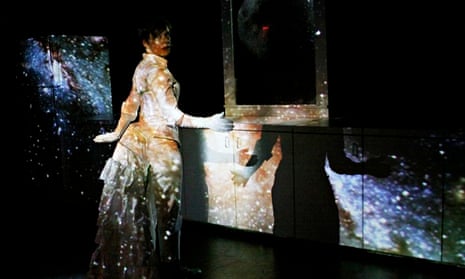We all have moments when we don’t quite feel ourselves. For some, though, fragmentation of the self is a biological as well as a psychological fact. Chimerism describes the medical state of having two sets of genetic material; it means, in other words, containing your own twin inside you.
This rare medical condition provides the unsettling premise for Deborah Stein and Suli Holum’s collaboration Chimera, which opens at the Gate theatre in west London this week. The show, written by Stein, performed by Holum and co-directed by the two women, tells the story of Jennifer Samuels, a scientist and mother who learns that she possesses two sets of DNA. Shaken by the discovery, Jennifer struggles to hold her splintered self together, while coming to terms with the idea that – genetically at least – her son is actually her nephew.
While Jennifer may be fictional, her crisis of identity stages an experience that is real. “The condition of being a medical chimera literalises something that I think is a pretty universal feeling,” Stein suggests, discussing the multiple versions of ourselves that we try to integrate on a daily basis. She was introduced to the science by Holum, who was intrigued by a true story she heard on the radio about a woman who discovered that her sons did not share her DNA. The pair decided to pursue the idea because, as Holum puts it, “neither of us could figure out immediately how it could be a play, how we could take this phenomenon and theatricalise it”.

Stein and Holum found their answer in a close weaving of form and content. As the show’s sole performer, Holum inhabits multiple characters, including Jennifer and her 19-year-old son Brian, while projections dance over her body and the smooth surfaces of the kitchen set. “Meaning is created by having these multiple voices in one body,” Stein explains, “because it’s about the condition of being more than one person, and one person, at the same time.” The kitchen, meanwhile, allows for “an exploration of surfaces and what lies beneath,” at the same time as suggesting and disrupting the traditional domestic sphere of the mother. “We do all kinds of surprising things with something that looks very simple and mundane,” says Holum.
The use of technology in Chimera, meanwhile, is an extension of the show’s central idea that “science and technology have got to the point now where they are showing us things that we have no framework for understanding”. Stein goes on to compare the way in which technology disrupts the lives of the play’s characters to how it has forced her and Holum out of their comfort zone as theatre-makers. What she has come to realise, however, is that the contradiction she initially perceived between the live theatrical experience and digital technology does not really exist. “Theatre is about being in the now, in the present moment, and our present moment has so much to do with screens and video and computer technology.”
What Chimera doesn’t do, its creators insist, is offer any answers to the scientific, moral and philosophical questions it throws open: questions about how far science and technology can define our existence, and the extent to which, if our sense of self is torn in two, we can be held accountable for our own actions. “We realised as we were working our way through the questions the play raises that we weren’t making something that answered those questions,” says Holum. “We realised we were working with questions big enough that they couldn’t be satisfactorily answered – and what we were creating was an event that didn’t tell the audience how to feel or think about something, but rather invited them to begin thinking about something and then carry that conversation forward after the event is over.”
“It sits in this really uncomfortable place of asking the audience to actually think and talk about things that we don’t usually get to think and talk about,” Stein adds, describing the play as a “stew” of ideas that we rarely consider alongside one another. “There’s pretty hard science in it, and then there’s also this story about a mother who doesn’t want to be a mother.”
This investigation of motherhood, it turns out, has been more provocative than the science, suggesting that Stein and Holum have hit on a collective raw nerve. In post-show discussions, the pair explain, it is Jennifer’s attempted flight from her responsibilities as a mother which has attracted the most debate. In this way, Chimera has travelled from the chilling but faraway realm of rare scientific phenomena to the more close-at-hand experiences of the theatre-makers and their audiences.
This journey is typical of the pair’s process, Holum tells me. “We start with research material, then we very quickly branch out pretty far afield from the original sources as we dive deeper and deeper into the process to unearth really what it was that drew us to the material.”
The questions they have arrived at are questions about identity, about motherhood, about the philosophy of science. But most of all, Holum suggests, Chimera asks what we believe in and where we find meaning.
“In the end we’re all searching for meaning, we’re all searching for a way of making sense of it all.”

Comments (…)
Sign in or create your Guardian account to join the discussion